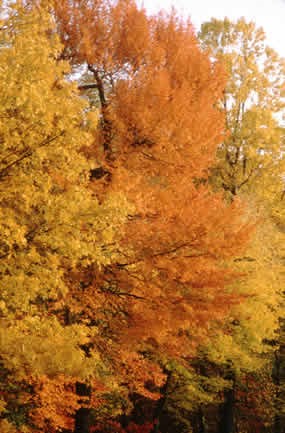
Vegetation surveys in 1940 (Berg and Moore, 1941), 1987 (Teetor, 1987), and 2009 (Young et al 2009), show dramatic changes in the forests of Shenandoah National Park over the last 750 years. Over time, natural succession has filled the areas of cleared and cultivated land that were present when the park was established with large stands of mature forest. These forests are pristine in some areas, but in other areas bear the signs of impact caused by natural and human caused disturbances such as fire, storms, and insect and disease outbreaks that have taken place over the years In 1940, Shenandoah was a young park , just five years post establishment. The landscape bore the unmistakable signs of nearly 200 years of human habitation and use including evidence of timbering, grazing, hunting and cultivation. It also bore the signs of high forest mortality caused by the American chestnut blight. In 1940 the park was 85% forested. Chestnut oak and northern red oaks covered 72% of the park. The rest of the park was open ground, including grasslands, cultivated fields, and old fields reverting to forest. Previously grazed areas were being occupied by bear oaks and pitch pines, yellow poplar stands were absent, and cove hardwood species such as maples, basswood, cherry, and birches covered only 6% of the land area. By 1987 the park was 55 years old and 95% forested. Chestnut oak and red oak cover had decreased to 59%, bear oak stands had disappeared, and pitch pine coverage had dwindled. Increasing cover was seen by other species. Yellow poplar stands had become well established in the drainages and now covered 16% of the park, and cove hardwood cover had increased to 15% coverage park-wide. The 2009 forest vegetation survey revealed a park landscape that remained 95% forested. However, oak and oak hickory dominated community cover had increased to 65% of the landscape, and cove hardwood forest cover had increased to 13%. Forest disturbances such as the gypsy moth, hemlock wooly adelgid, hurricanes, and ice storms, among others; have rendered a full 17% of the park vegetation communities as early-successional or disturbed vegetation types. These include the successional Tuliptree forest (6.5% of park land), and the northeast modified successional forest (5.5% of park land). In 2009, 5% of park forests were so disturbed that they could not be classified as anything other than "catastrophically disturbed forest". Aside from change brought about by sudden events such as flooding, ice storms, or wildland fires, most park visitors will not witness forest change. Forest communities may seem to be constant over the short-term, but if examined over a long enough time scale, can been appreciated as very dynamic. Successional change, response to natural disturbances, and encroachment of non-native species occurs gradually, taking years or decades. Today's areas of intense disturbance may seem beyond recovery, but through the processes of forest succession and responsible forest management, may one day be the Old Growth forests of tomorrow. Related Information Teetor, A. 1988. Identification and mapping of vegetation communities in Shenandoah National park, Virginia, final report MAR-34. National Park Service Sutton, A. and M. Sutton. 1985. Eastern Forests. Alfred A. Knopf, New York, New York. Young, J., G. P. Fleming, W. B. Cass, and C. Lea. 2009. Vegetation of Shenandoah National Park in relation to environmental gradients, version 2.0. Technical Report NPS/NER/NRTR-2009/142. National Park Service, Philadelphia, Pennsylvania
Websites that provide helpful information about deciduous forests include:
Listing of these websites does not and is not intended to imply endorsement by the National Park Service of commercial services or products associated with the sites. |
Last updated: October 31, 2019
